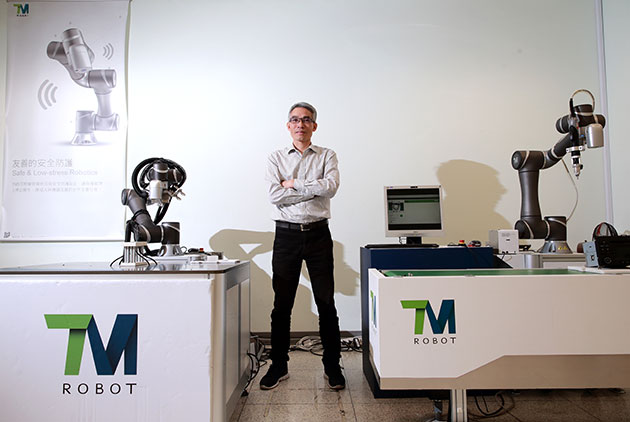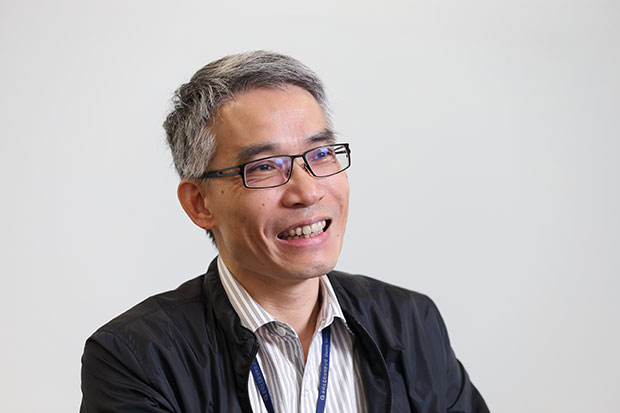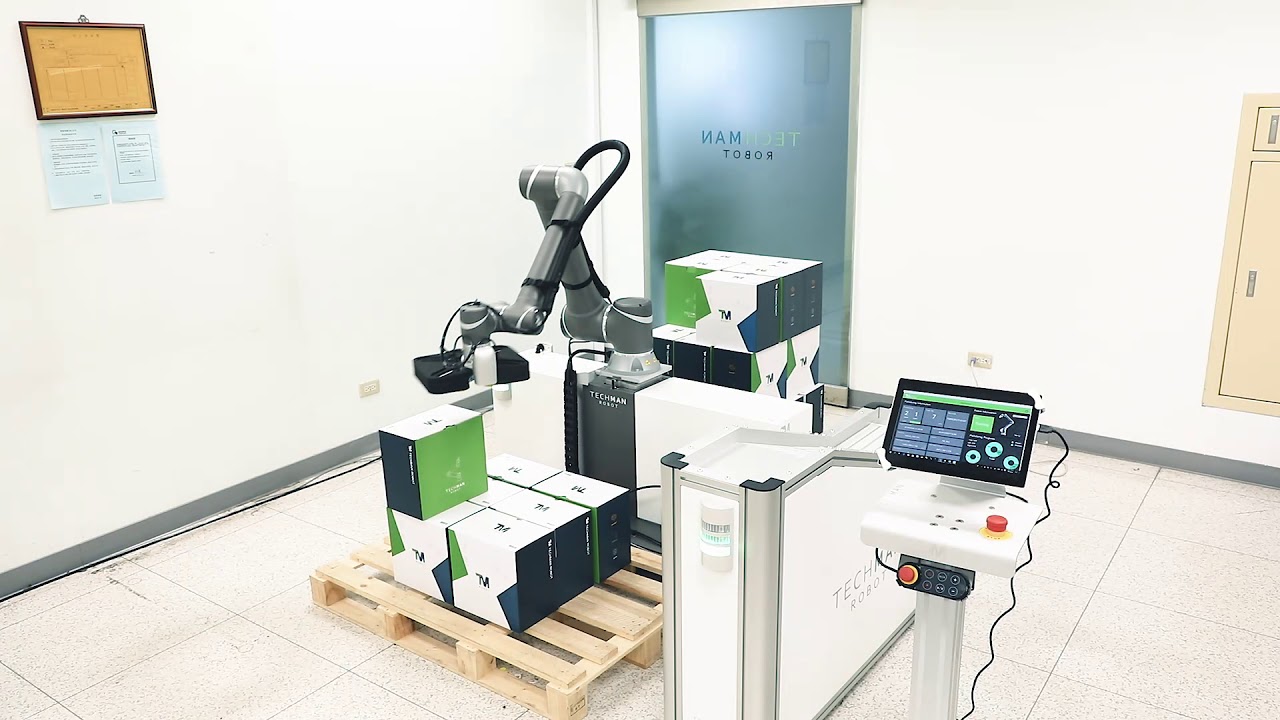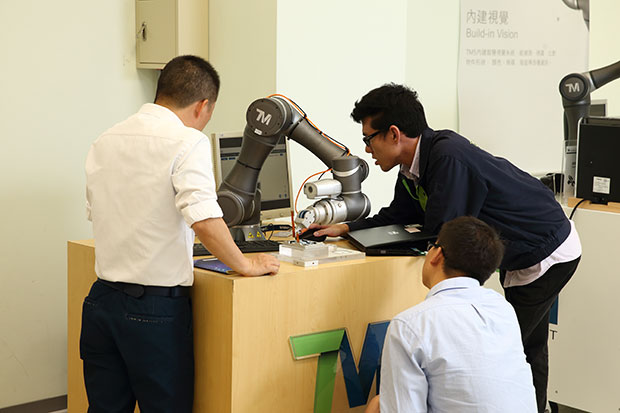This Made-in-Taiwan Robot Is Drawing International Attention

Source:Chien-Tong Wang/CW
Quanta Computer subsidiary Techman Robot Inc. has emerged as the world’s second biggest maker of collaborative robots.
How has this Made in Taiwan robot company hit it big globally and what are some of the new opportunities coming its way?
The reception room outside the office of Quanta Computer Chairman Barry Lam has recently introduced a new gadget that can move on its own – a robot that “serves” tea to every visitor who passes through.
The unmanned robot moves freely around customers and places the coffee or tea guests have asked for on their coasters without making any mistakes. The robot’s “eyes” visually identifies each guest’s coaster to match them with the right beverages, helping it deliver the drinks with absolute precision.
This new favorite of Barry Lam is the masterpiece of Techman Robot Inc., a Made-in-Taiwan brand developed by Quanta Computer subsidiary Quanta Storage Inc.
The robot in Barry Lam’s reception room possesses only the most basic functions, but the company’s collaborative “TMRobots” come with built-in visual recognition capabilities. These robots are being applied to processes in assembling notebook computers and servers and on automobile and flat panel display production lines that many thought robots would have a difficult time handling.
The biggest difference between Techman Robot products and those of other more traditional robot makers is their user interface, which functions similarly to a smartphone app.
Where users needed more than a month in the past to fully integrate a robotic system, the process has now been reduced to five minutes, saving factories big and small substantial manpower and equipment costs.
Meteoric Rise in a Two-year Span
That innovation helped Techman Robot, which only began selling its products commercially in 2016, become the world’s second largest vendor of collaborative robots by 2018 behind only Danish company Universal Robots, according to market research firm Interact Analysis.
That meteoric rise was unimaginable just a few years earlier, for Techman Robot represents the comeback story of a group of CD-ROM drive engineers who were spurned by their “parents” and had to grow up and make it on their own.
The company is located in the Hwa Ya Technology Park in Guishan District in Taoyuan, situated unobtrusively in the Quanta Storage factory and office complex across from the massive headquarters of Quanta Computer.
Techman Robot CEO Chen Haw and Chairman Ho Shi-chi previously were colleagues at major CD-ROM drive vendor Lite-On Technology. They then decided to set up Quanta Storage, which developed the world’s first thin CD-ROM drive, helping it battle with IC design house MediaTek Inc. at one point for the title of having the highest stock price on Taiwan’s market.
 Techman Robot CEO Chen Haw says his transition from CD-ROM development to robot manufacturing was a return to his roots because he studied robotics and electronic controls at National Chiao Tung University. (Photo by Chien-Tong Wang/CW)
Techman Robot CEO Chen Haw says his transition from CD-ROM development to robot manufacturing was a return to his roots because he studied robotics and electronic controls at National Chiao Tung University. (Photo by Chien-Tong Wang/CW)
In describing his transition to the seemingly unrelated robotics sector, Chen jests, “I was forced into it.” But his joke contains far more than a grain of truth.
Chen recalls that soon after Quanta Storage went public, Lam came by to congratulate the company on its listing and then told Ho and Chen: “CD-ROM drives will one day disappear.” Fresh off the high of going public, Chen underestimated the bad omen.
In fact, Lam’s warning proved prophetic. The rise of broadband internet encouraged the younger generation to watch videos online, and the introduction of solid state drives (SSD) led to thinner notebook computers. Many people even started doing all of their computer operations on their smartphones, a technology transition that has gradually eliminated CD-ROMs from the marketplace.
“Even I don’t use CD-ROMs much. At the time, I was thinking about how to apply some of our core competencies to develop new products,” Chen recalls.
CD-ROMs and Robots Not So Dissimilar
From the outside looking in, transitioning from CD-ROM drives to robots might represent a massive leap, but to Ho and Chen, it actually brought them back to their educational roots.
Ho earned a Ph.D. from Imperial College London in the field of medical robotics, while Chen studied robotics and electronic controls at National Chiao Tung University
“At the time I graduated, most of my classmates either entered the semiconductor field or went to the National Chung-Shan Institute of Science & Technology to make missiles,” says Chen, who recalls having no interest in working as a production line engineer, preferring instead to go into R&D. Because CD-ROM drives were taking off, Chen was drawn into the field as a researcher.
In his mind, his old and new disciplines are not as disparate as one might think.
“In fact, at the heart of both robots and CD-ROMs are controls,” Chen says bluntly, referring to the mechanical, optical and electronic control concepts behind the two products.
In 2011, Quanta Storage had a solid foundation of robotic technology talent, including Ho and Chen, and it began to invest in the development of robots. The company initially worked with the Industrial Technology Research Institute for a year on four-axis robotic arms.
But after that year in the project, Chen decided to abandon the traditional four-axis model after discovering that no matter how much effort he put into it, it would be hard to create something clearly different from other products on the market.
In his mind, that made such a product almost impossible to sell – price it cheaply, and Chinese factories would undercut it; price the product more expensively for a higher end market and customers would buy European brands. Nobody was interested on taking a chance on a new Taiwanese brand, he felt.
Just as Chen was struggling to find a new product, he drew inspiration from global collaborative robot leader Universal Robots. When the Danish company paid a visit to Quanta Storage, Chen got a look at one of its robots and was stunned because of its mobility. The visitors could pull it into Quanta Storage’s lab and place it anywhere and maneuver it freely.
“At that time, I said this is what we should hope to be making because unlike traditional models that were usually enclosed [for safety], the robotic arm could move around freely,” he recalls.
 Source: YouTube@Techman Robot
Source: YouTube@Techman Robot
Lack of Robotics Past a Positive
In 2011, the use of collaborative robots – essentially robotic arms that can learn multiple tasks and assist human beings – remained rare around the world, with fewer than 2,000 units deployed. Even major Japanese industrial robot vendor Kuka only had conceptual models at that point, but Chen and Ho were fully convinced of the future development potential of the product line and decided to put their effort into it.
At the time, the 60-person team racked their brains to come up with ways to develop products that clearly offered something different from those on the market.
“It was difficult to make a breakthrough on the design of the appearance [of the robots]. We hoped to differentiate ourselves from others through the user interface,” Chen says.
Coming from consumer electronics’ backgrounds, Quanta Storage’s engineers were not burdened by thinking tied to traditional robotic arm design, and that showed in their attempt to design products using interfaces featuring screens of icons to choose from.
“When you open the UI, you will see the user interface of an electronics product, like a smartphone or computer app. It is very easy to use,” says Peter Huang, director, of Techman Robot’s Brand Marketing & Design Center.
Though the design concepts are geared toward industrial applications, Techman has insisted they also follow the intuitive logic that guides the usage of consumer products. Once the company’s software is uploaded into the robots, they can be operated using a smartphone or tablet computer, a major departure from traditional industrial robots requiring complex operating manuals and software code.
In addition, unlike other robotics companies that have recently moved to add suddenly popular visual recognition software to their robotic arms, Quanta Storage engineers have designed visual recognition functions directly into the robots they make.
 Photo by Chien-Tong Wang/CW
Photo by Chien-Tong Wang/CW
Drawing International Attention
In 2015, Quanta Storage named the robot it developed in-house “TechMan” (TM), and brought it to the International Robot Exhibition in Tokyo to show it overseas for the first time. In breaking the mold of traditional industrial robots with its interface design, the new robot caught the eye of other exhibitors, prompting Quanta Storage Vice Chairman C.C. Leung to fly to Japan when he heard the news.
The next year, the company exhibited TechMan at the Hanover Fair in Germany, and formally established Techman Robot at the end of the year.
When representatives of an auto parts vendor saw the TechMan at a trade show in South Korea, they told Techman Robot employees: “Your product is like a smartphone while traditional robotic arms are like feature phones.”
“When I heard that analogy from the big car brand, it made me really happy,” Chen says, revealing that the parts maker later became one of Techman Robot’s clients.
Techman Robot’s market share closed in on that of the number two player in the market, Fanuc, in 2017 but still ranked third, while the fourth-ranked company, Boston-based collaborative robot maker Rethink Robotics, declared bankruptcy in October 2018 and had its patents purchased by Hahn of Germany.
By 2018, Techman Robot had risen to the second largest collaborative robot maker in the world behind Universal Robots. In just two years, Techman Robot had built a supplier network of more than 100 companies spanning Europe, the United States, Japan and China.
The company’s robots, recognized as being mobile, easy to install and capable of working with people, are now being quietly applied to production processes for consumer electronics products, such as notebook computers, automotive parts and flat panel displays, that were long considered difficult to automate and dispense with human workers.
Techman’s Trade War Opportunity
The trade war between the United States and China may be providing Techman Robot with a new opportunity. Taiwanese companies producing certain electronics products such as servers and notebook computers in China are pondering returning some of their production capacity to Taiwan, and Techman Robot could provide a helping hand. (Read: Terry Gou Moving Hon Hai Production Lines from Shenzhen to Kaohsiung)
Notebook computers, for example, require adhesives to bond their shell and for other applications. In the past, workers were needed to apply the adhesive, but those tasks can now be done by a Techman Robot collaborative robot.
The same is true for the laser engraving of logos on smartphones. Using their visual recognition capabilities, Techman robots can place smartphone casings precisely under the laser, and then send the casing to the next step automatically once the engraving is done. By deploying robots to do these repetitive tasks, companies can free up manpower that is in scare supply in Taiwan to perform other jobs. (Read: Taiwan, Unexpected Beneficiary of US-China Trade War)
Another application has been the SMT (surface-mount technology) process used in servers and notebooks, in which Techman robots can replace about 70-80 percent of the manpower normally used.
“An SMT production line requires over 20 people to put PC boards in place, turn them over, cut them, and test them. Collaborative robots can be used for all of these steps, but if you use traditional robotic arms that have to be in safety enclosures, SMT lines will not fit. We have a good opportunity here,” Chen says with confidence.
His confidence is well founded. Quanta Storage robots are being used in several production processes, including on SMT lines, in notebook and server manufacturing facilities such as Quanta Computer plants in Linkou, Taiwan, and Songjiang, China.
But Chen was unwilling to provide too many details on exactly how his robots were being used because of client confidentiality concerns with Quanta Computer clients such as Apple, Google, Facebook and Amazon.
Regardless of the details, what once was a 60-person team has now grown into an operation with about 300 employees, and Techman Robot continues to expand its production capacity.
“Right now, many production lines are becoming very modular, with many repetitive, monotonous tasks that can be performed by robots. We also hope to enable people to do things that provide greater value,” Chen says. (Read: Local Microfactories – Lower Costs, Higher Efficiency)
Ultimately, this group of CD-ROM engineers who were nearly cast aside by technological advances was able to change fields and once again achieve new heights. As Chen says: “You have to constantly look for ways to differentiate yourself if you want to stay competitive.”
Translated by Luke Sabatier
Edited by Sharon Tseng
Source: CommonWealth Magazine https://english.cw.com.tw/article/article.action?id=2436
